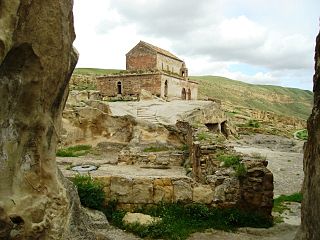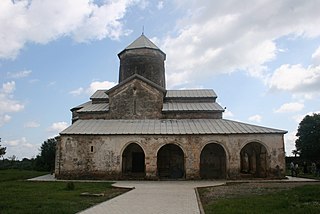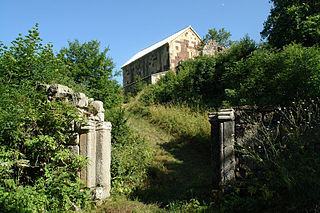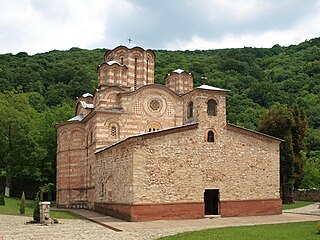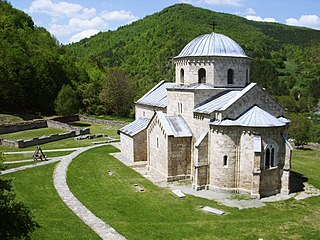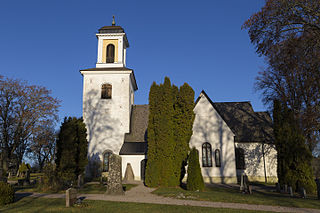
Timotesubani (Georgian :ტიმოთესუბანი) is a medieval Georgian Orthodox Christian monastic complex located at the eponymous village in the Borjomi Gorge, Georgia's Samtskhe-Javakheti region.

Georgian is a Kartvelian language spoken by Georgians. It is the official language of Georgia. Georgian is written in its own writing system, the Georgian script. Georgian is the literary language for all regional subgroups of Georgians, including those who speak other Kartvelian languages: Svans, Mingrelians and the Laz.

Borjomi Gorge is a picturesque canyon of the Kura River in central Georgia. The gorge was formed as a result of the Kura River cutting its path through the Lesser Caucasus Mountains where the Trialeti and Meskheti Ranges meet. A significant portion of the Borjomi Gorge is covered by mixed and coniferous forests made up of oak, maple, beech, spruce, fir, and pine. A large portion of the Borjomi-Kharagauli National Park lies within the gorge, as well as the towns of Likani and Borjomi itself.

Georgia is a country in the Caucasus region of Eurasia. Located at the crossroads of Western Asia and Eastern Europe, it is bounded to the west by the Black Sea, to the north by Russia, to the south by Turkey and Armenia, and to the southeast by Azerbaijan. The capital and largest city is Tbilisi. Georgia covers a territory of 69,700 square kilometres (26,911 sq mi), and its 2017 population is about 3.718 million. Georgia is a unitary semi-presidential republic, with the government elected through a representative democracy.
The complex consists of a series of structures built between the 11th and 18th centuries, of which the Church of the Dormition is the largest and artistically most exquisite edifice constructed during the "Golden Age" of medieval Georgia under Queen Tamar (r. 1184-1213). A contemporary inscription commemorates the Georgian nobleman Shalva of Akhaltsikhe as a patron of the church.

The term Golden Age comes from Greek mythology, particularly the Works and Days of Hesiod, and is part of the which comes from the golden agen of temporal decline of the state of peoples through five Ages, Gold being the first and the one during which the Golden Race of humanity lived. Those living in the first Age were ruled by Kronos, after the finish of the first age was the Silver, then the Bronze, after this the Heroic age, with the fifth and current age being Iron.

Tamar the Great reigned as the Queen of Georgia from 1184 to 1213, presiding over the apex of the Georgian Golden Age. A member of the Bagrationi dynasty, her position as the first woman to rule Georgia in her own right was emphasized by the title mepe ("king"), afforded to Tamar in the medieval Georgian sources.
A reign is the period of a person's or dynasty's occupation of the office of monarch of a nation, of a people or of a spiritual community. In most hereditary monarchies and some elective monarchies there have been no limits on the duration of a sovereign's reign or incumbency, nor is there a term of office. Thus, a reign usually lasts until the monarch dies, unless the monarchy itself is abolished or the monarch abdicates or is deposed.
The church is a domed cross-in-square design built of pink stone, with three apses projecting on the east. Its dome rests upon the two freely standing pillars and ledges of the altar. Later, two – the western and southern – portals were added.
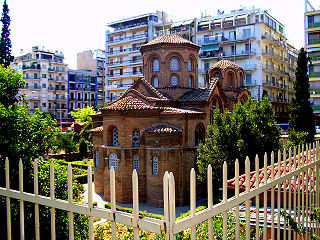
A cross-in-square or crossed-dome plan was the dominant architectural form of middle- and late-period Byzantine churches. It featured a square centre with an internal structure shaped like a cross, topped by a dome.
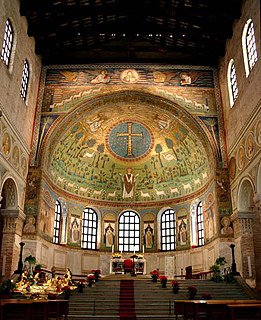
In architecture, an apse is a semicircular recess covered with a hemispherical vault or semi-dome, also known as an exedra. In Byzantine, Romanesque, and Gothic Christian church architecture, the term is applied to a semi-circular or polygonal termination of the main building at the liturgical east end, regardless of the shape of the roof, which may be flat, sloping, domed, or hemispherical. Smaller apses may also be in other locations, especially shrines.

An altar is a structure upon which offerings such as sacrifices are made for religious purposes. Altars are found at shrines, temples, churches and other places of worship. They are used particularly in Christianity, Buddhism, Hinduism, Shinto and Taoism. Judaism used such a structure until the destruction of the Second Temple. Many historical faiths also made use of them, including Roman, Greek and Norse religion.
The interior was extensively frescoed in no later than 1220s. The Timotesubani murals are noted for their vivacity and complexity of iconographic program. [1] These frescoes were cleaned and studied by E. Privalova and colleagues in the 1970s and underwent emergency treatment and conservation with aid from the World Monuments Fund and the Samuel H. Kress Foundation in the 2000s. [2]
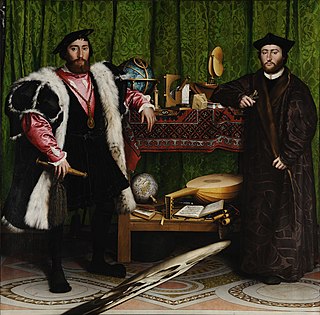
Iconography, as a branch of art history, studies the identification, description, and the interpretation of the content of images: the subjects depicted, the particular compositions and details used to do so, and other elements that are distinct from artistic style. The word iconography comes from the Greek εἰκών ("image") and γράφειν.
World Monuments Fund (WMF) is a private, international, non-profit organization dedicated to the preservation of historic architecture and cultural heritage sites around the world through fieldwork, advocacy, grantmaking, education, and training.



